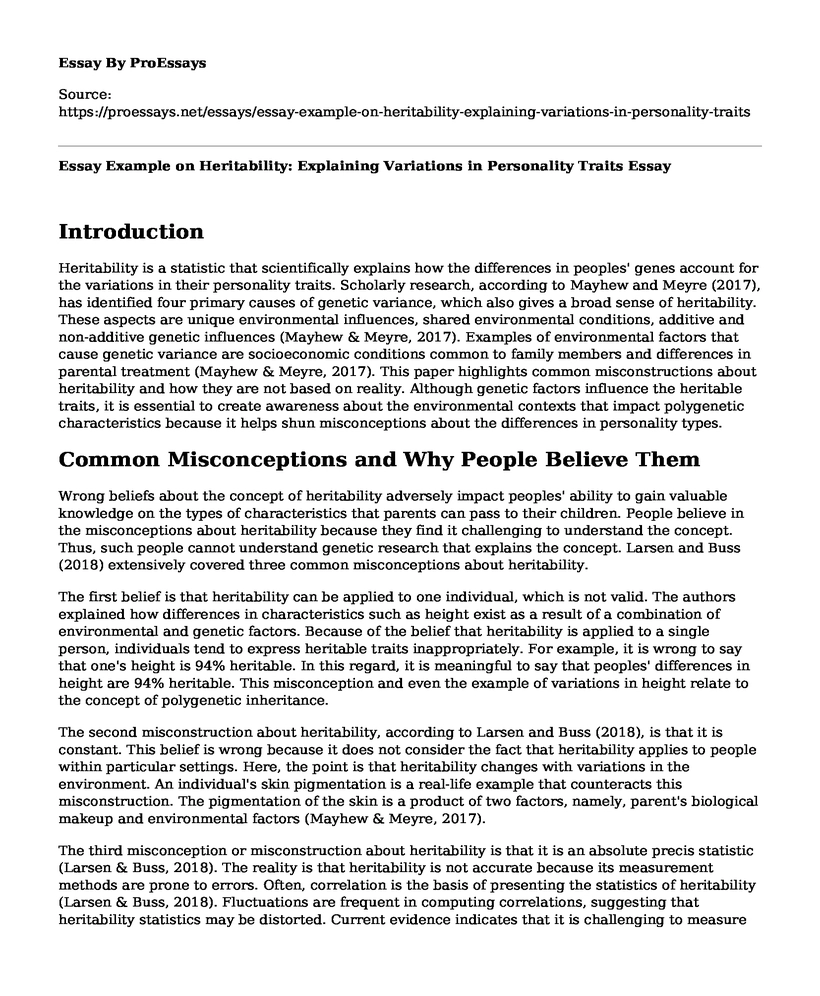Introduction
Heritability is a statistic that scientifically explains how the differences in peoples' genes account for the variations in their personality traits. Scholarly research, according to Mayhew and Meyre (2017), has identified four primary causes of genetic variance, which also gives a broad sense of heritability. These aspects are unique environmental influences, shared environmental conditions, additive and non-additive genetic influences (Mayhew & Meyre, 2017). Examples of environmental factors that cause genetic variance are socioeconomic conditions common to family members and differences in parental treatment (Mayhew & Meyre, 2017). This paper highlights common misconstructions about heritability and how they are not based on reality. Although genetic factors influence the heritable traits, it is essential to create awareness about the environmental contexts that impact polygenetic characteristics because it helps shun misconceptions about the differences in personality types.
Common Misconceptions and Why People Believe Them
Wrong beliefs about the concept of heritability adversely impact peoples' ability to gain valuable knowledge on the types of characteristics that parents can pass to their children. People believe in the misconceptions about heritability because they find it challenging to understand the concept. Thus, such people cannot understand genetic research that explains the concept. Larsen and Buss (2018) extensively covered three common misconceptions about heritability.
The first belief is that heritability can be applied to one individual, which is not valid. The authors explained how differences in characteristics such as height exist as a result of a combination of environmental and genetic factors. Because of the belief that heritability is applied to a single person, individuals tend to express heritable traits inappropriately. For example, it is wrong to say that one's height is 94% heritable. In this regard, it is meaningful to say that peoples' differences in height are 94% heritable. This misconception and even the example of variations in height relate to the concept of polygenetic inheritance.
The second misconstruction about heritability, according to Larsen and Buss (2018), is that it is constant. This belief is wrong because it does not consider the fact that heritability applies to people within particular settings. Here, the point is that heritability changes with variations in the environment. An individual's skin pigmentation is a real-life example that counteracts this misconstruction. The pigmentation of the skin is a product of two factors, namely, parent's biological makeup and environmental factors (Mayhew & Meyre, 2017).
The third misconception or misconstruction about heritability is that it is an absolute precis statistic (Larsen & Buss, 2018). The reality is that heritability is not accurate because its measurement methods are prone to errors. Often, correlation is the basis of presenting the statistics of heritability (Larsen & Buss, 2018). Fluctuations are frequent in computing correlations, suggesting that heritability statistics may be distorted. Current evidence indicates that it is challenging to measure heritable traits (Mottus et al., 2019). Scientists employ tools like the Five-Factor Model to present and explain personality variance in individuals. While personality models can capture a hallmark of personality traits, it has a weakness because it cannot rate characteristics that change over time (Mottus et al., 2019). This point shows that the belief that heritability is based on precis statistics is not based on reality.
Conclusion
There is a need to create awareness about the concept of hereditability as a way to shun misunderstanding about how genes influence personality traits. The complexity of this concept explains why people still believe in misconceptions about heritability. The reality is that heritability is not an absolute precis statistic, and it changes with environmental contexts.
References
Larsen, R., & Buss, D. (2018). Personality psychology: Domains of knowledge about human nature: 6th Edition. New York, NY: McGraw-Hill Higher Education.
Mayhew, A. J., & Meyre, D. (2017). Assessing the heritability of complex traits in humans: Methodological challenges and opportunities. Current Genomics, 18(4). https://doi.org/10.2174/1389202918666170307161450
Mottus, R., Sinick, J., Terracciano, A., Hrebickova, M., Kandler, C., Ando, J., Mortensen, E. L., Colodro-Conde, L., & Jang, K. L. (2019). Personality characteristics below facets: A replication and meta-analysis of cross-rater agreement, rank-order stability, heritability, and utility of personality nuances. Journal of Personality and Social Psychology, 117(4), e35-e50. https://doi.org/10.1037/pspp0000202
Cite this page
Essay Example on Heritability: Explaining Variations in Personality Traits. (2023, Apr 06). Retrieved from https://proessays.net/essays/essay-example-on-heritability-explaining-variations-in-personality-traits
If you are the original author of this essay and no longer wish to have it published on the ProEssays website, please click below to request its removal:
- Animal Abuses Essay Example
- Essay Sample on Data Visualization: A Vital Tool for Statistics Experts
- IEEE EMBS: A Global Biomedical Engineering Society - Research Paper
- Genetically Modified Organisms: Ethical, Safety, and Production Concerns - Essay Sample
- Paper Example on CDC's ADHD Info: A Rhetorical Analysis
- Behaviorist & Psychoanalytical Views on Early Childhood Personality Development
- Innate Ambition: Unveiling the Nature of Human Drive for Success - Free Paper Example







